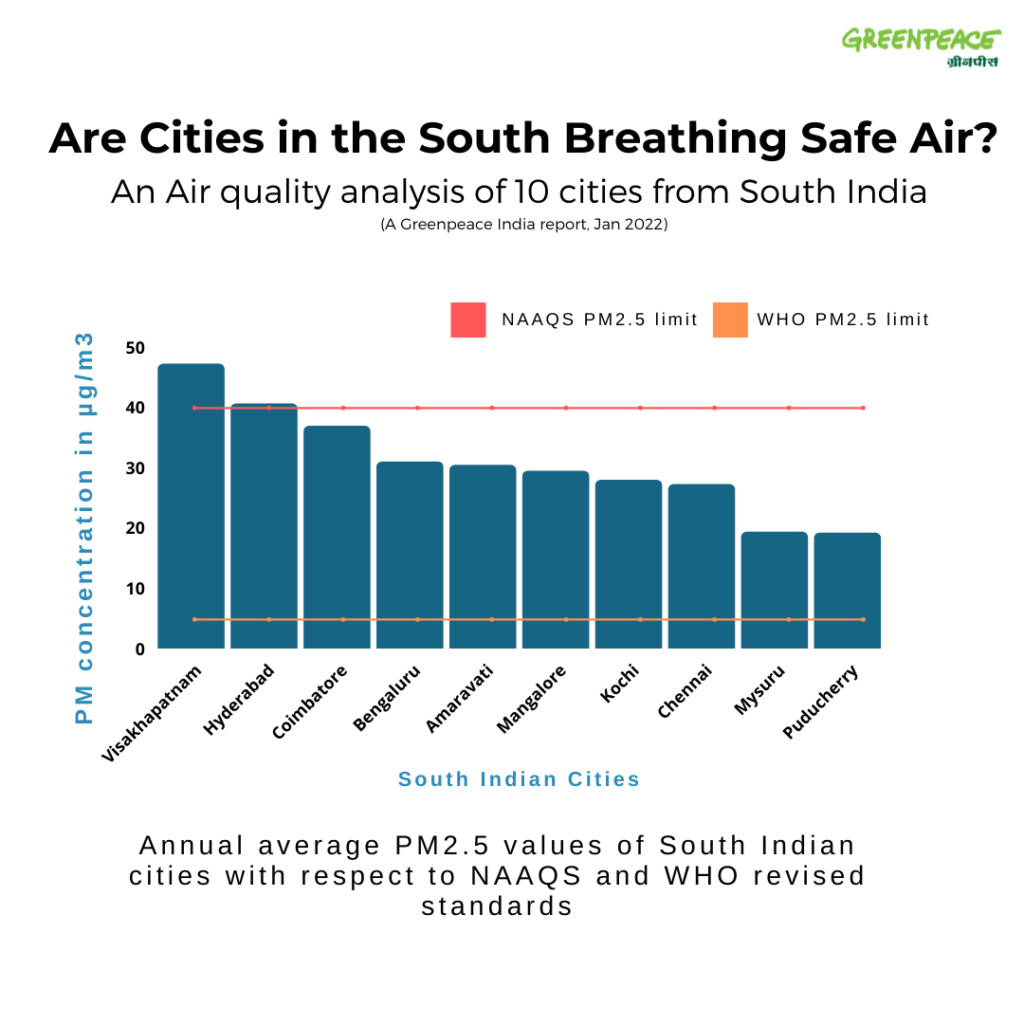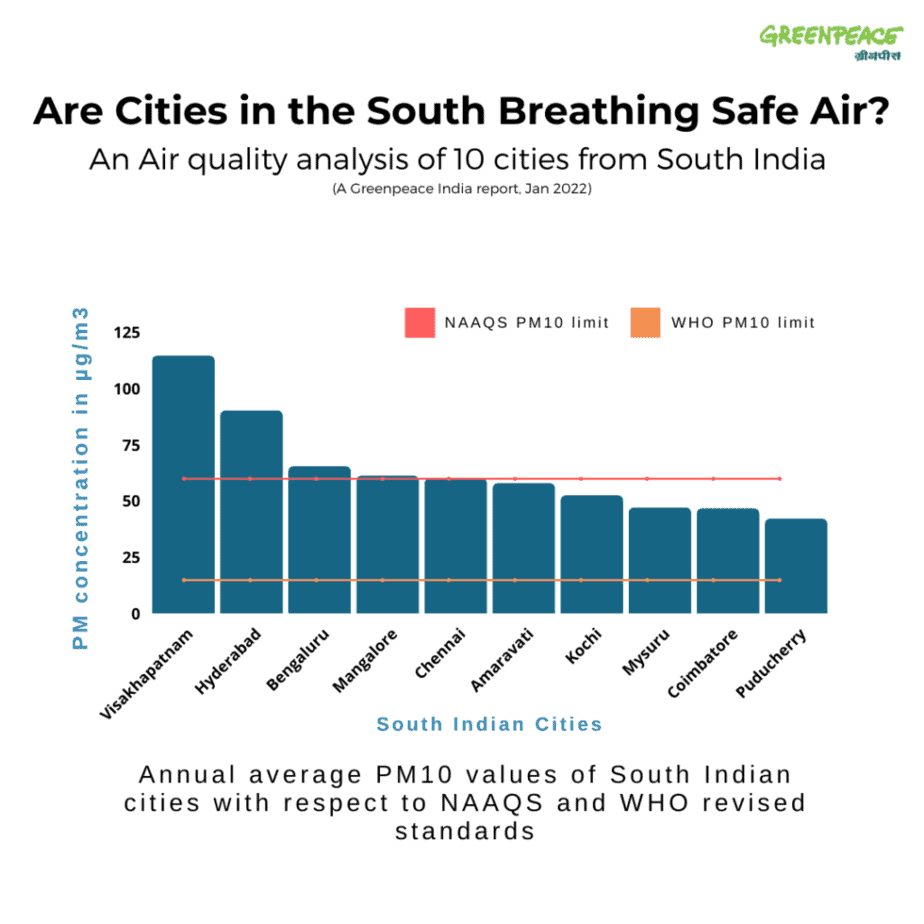A latest report by Greenpeace India reveals that average air pollution levels in ten major cities of Southern India far exceed the latest World Health Organization (WHO) guidelines, by analysing the Central Pollution Control Board (CPCB)’s data. The analysis is a much needed reminder that air pollution is a public health crisis that is not confined to cities only in Northern India.
What data reveals
Air pollution data from ten cities – Bengaluru, Hyderabad, Chennai, Amaravati, Visakhapatnam, Kochi, Mangalore, Puducherry, Coimbatore and Mysore – were selected and analysed based on the availability of data, population and monitoring station networks. It was found that despite pandemic-induced lockdowns and subsequent reduction in economic activities, the annual average values of PM2.5 and PM10 exceeded WHO revised standards by many folds.
Coimbatore, Bengaluru, Mangalore and Amaravati saw annual PM2.5 levels exceed WHO guidelines of 5 µg/m3 by 6 to 7 times. While in Mysuru, Kochi, Chennai and Pondicherry, PM2.5 levels exceeded the guidelines by 4 to 5 times.
In comparison, while annual PM10 levels in Visakhapatnam and Hyderabad exceeded the prescribed WHO guidelines of 15 µg/m3 by 6 to 7 times, Bengaluru, Mangalore, Amaravati, Chennai and Kochi recorded data that exceeded the limit by 3 to 4 times. Mysore, Coimbatore and Pondicherry recorded PM10 data that exceeded the WHO guidelines for safe air by 2 to 3 times.
The primary contributors to worsening the air quality are fossil fuel powered infrastructural development, industries, transport, waste burning and construction activity. Chronic exposure to air pollution increases the likelihood of asthma, low birth weight, depression, schizophrenia, diabetes, stroke, lung cancer and can cause premature deaths.
Read more: Will 2022 bridge the yawning gaps in national and state level clean air action?
Sustainability and affirmative action
Commenting on the analysis, Avinash Chanchal, Campaign Manager, Greenpeace India says: “The data shows that lockdown is not a solution to air pollution. Relatively lesser economic activity and vehicles is also putting us in a dangerous position. We have to prioritize the immediate shift to clean energy and clean transport to stop more damage. If we look at Bengaluru’s PM10 data, the annual average in most stations is exceeding not only WHO guidelines, but NAAQS levels too.
“Making our urban transport networks accessible and sustainable can play a major role in combating India’s urban air pollution crisis. Majority of the population in these cities is already using public transport or sustainable ways of transportation. But the infrastructural focus is still on private vehicles. Efforts and lifestyle of the masses must be appreciated and encouraged as they are contributing to making our cities sustainable.” Avinash Chanchal
“The pollution control boards must realise that no level of air pollution is safe and even the long term exposure of lower level of concentrations of air pollution can severely impact human health. Thus, the CPCB must revise the current national ambient air quality standards for all pollutants based on WHO’s proposed interim target and gradually achieve the revised standards.” he adds.
Greenpeace India’s Power The Pedal campaign is working with low-wage women labourers in Bengaluru and Delhi with the aim of building cycling communities that will act as agents of change. The first 500 bicycles are being delivered in the first phase. Honamma, a 38-year-old garment factory labourer from the IT capital says that she feels proud she is part of the solution to her city’s pollution problems. “I am proud that since I am cycling I am not adding to the problem. But there are not enough facilities for cyclists. We don’t have enough cycle tracks and are constantly exposed to a lot of pollution from other vehicles. So if we have a separate lane then it will be better. There are parking facilities for motorists, we need such facilities for cyclists as well. If we want change then we have to ensure such facilities are provided.”
This article is based on a Press Release and information shared by Greenpeace India and has been published here with minimal edits.


Air pollution is a silent killer many do not have the slightest idea how it affects our lungs. Young children and elderly are very much affected by air pollution. Itchy eyes, nasal congestion, sneezing and asthma are becoming common these days. Everybody wants to own a car nobody bothers about using public transportation or car pool . The increased number of cars on road is mainly driving air pollution and green house gases. Schools should advise parents to use school bus or walkers /bicycles . These days when I go to drop kids at school ( we walk) I see none walk or use school bus every kid proudly gets down from car. Without knowing what we are paying for a car ride, our kids health/ and their future.